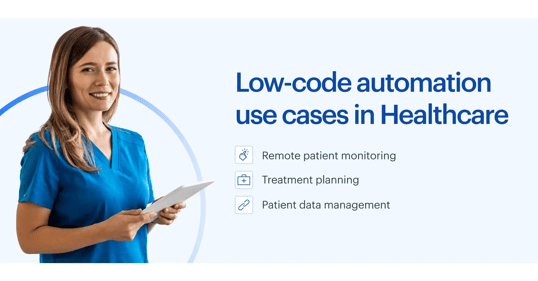The rising need for digital infrastructure to improve healthcare has led to the adoption of low-code technology. One-size-fits-all applications can't fulfil the needs of various branches of healthcare. Low code accelerates development cycles to meet the needs of patients and healthcare organizations in real-time.
Low-code automation in healthcare makes solutions cheaper and more accessible to non-technical users. A 2019 Forrester survey revealed that low code has become a practical alternative to custom coding. Low-code platforms offer quick and efficient deployment of custom-built applications. These apps use less code than standard applications and are more user-friendly.
What is low-code automation for healthcare?
Low-code automation in healthcare means developing solutions that improve service delivery and patient experiences. Low-code platforms have fewer technical requirements, making them accessible to people outside of IT. Non-technical medical professionals can use these platforms to automate processes and develop highly responsive applications that streamline their work.
Healthcare application development is the process of creating a smartphone app mainly for healthcare and wellness. This helps a person manage their disease better and guide enthusiasts toward their wellness goals.
The healthcare industry deals with a lot of information and records every day. Healthcare professionals can use low-code technology to digitize processes, improve clinical outcomes, and curb healthcare costs. They can use apps, digital services, and data insights to create a thriving ecosystem that enables them to deliver quality and sustainable healthcare for all. Low-code platforms allow users to create effective digital health solutions.
Challenges and inefficiencies in the current healthcare system

No remote access
Healthcare often means in-person consultations. When people need medical attention, they usually go to the nearest medical center for treatment. But the COVID pandemic and subsequent lockdowns made it clear that this model was ineffective. People who were suffering from non-life-threatening conditions had to stay in their homes.
The pandemic showed us the great need for virtual consultations and telehealth. Every healthcare organization needs mobile and web applications to improve service delivery. Applications allow medical experts to provide quality care to patients miles away.
Siloes in the healthcare world
A healthcare organization comprises different teams and specialties—doctors, nurses, administrators, support staff, and even lawyers. But these teams are often siloed and lack communication and input.
A low-code platform brings different teams together to discuss ideas, share knowledge, and develop solutions. Everyone works together for better patient outcomes.
Poor supply chain management
The logistics behind healthcare services are the backbone of the industry. Good logistics mean better healthcare services. But most healthcare facilities have a hard time managing logistics. This creates issues like mismanaged medical inventory and equipment or drug shortages. Doctors fail to deliver efficient services and may put patients' health at risk.
Healthcare providers must use a digital supply chain management system to avoid massive losses and unnecessary spending. The system should be powered by data analytics so medical professionals can access accurate inventory numbers and information.
Learn more about logistics management software.
Poor management of patient data
Without the right system, managing patient data can be overwhelming. Whenever a new patient gets added to the database, the data pool becomes bigger and harder to manage. Data mismanagement can lead to wrong diagnoses, lapsed appointments, improper treatment, and much more. The results can be catastrophic for both doctors and patients.
A cloud workflow software gives healthcare professionals real-time access to patient data. Records are updated in real-time, so it becomes easier to manage patients and provide quality healthcare.
Benefits of using low-code automation in healthcare
Healthcare professionals take part in app development
Because low-code platforms are simple and accessible, they empower healthcare organizations to build more solutions with the same resources. Subject matter experts, business analysts, and database managers can use this technology to speed up business processes.
Low-code development platforms also enable healthcare organizations to test applications quickly. 50 percent of enterprises say that low-code development offers faster delivery than any other development approach. Citizen developers can constantly improve enterprise applications and workflows without compromising efficiency and productivity.
Improved compliance
Compliance in health care can be challenging because numerous third parties are involved. A healthcare organization must choose partners who meet emissions standards, avoid suppliers in embargoed countries, understand cold chain management for vaccines, manage regulatory compliance for pharmaceuticals, and much more.
A healthcare provider can efficiently track key compliance metrics using a low-code platform and get automated alerts when a potential compliance risk arises. Compliance officers can easily manage regulatory compliance by tracking patient documentation, insurance requirements, and critical data.
Streamlined administrative and supply chain processes
Low-code applications with new technologies like artificial intelligence (AI) and machine learning (ML) can streamline administrative and supply chain processes. They can help healthcare organizations to improve resource allocation, drug delivery, and supply management.
Low-code platforms augment core supply chain systems, empowering subject matter experts to build apps that offer better insights into data and workflows.
Enhanced scheduling
Every healthcare organization needs a scheduling system to communicate and coordinate important data. A low-code development platform enables healthcare professionals to develop applications that can quickly gather, analyze, and communicate data with users.
It becomes easier to consolidate important information and improve administrative processes. Healthcare organizations significantly improve service delivery as well as patient experiences.
Use cases of low-code automation in healthcare

Remote patient monitoring
Remote patient monitoring benefits patients, providers, caregivers, and the healthcare industry as a whole. Low-code tools support remote patient monitoring, increasing access to virtual care and reducing the total cost of care.
Remote patient monitoring allows healthcare providers to manage acute and chronic conditions. It also cuts down on patients' travel costs and infection risk. Additionally, patients have the comforting perception that their doctor is regularly watching over them.
Treatment planning
Treatment plans guide medical professionals on how best to deliver services. Doctors can use low-code platforms to develop treatment plans that monitor patients' progress and lead them toward their healthcare goals. They can adjust the treatment to provide better healthcare. Medical professionals who don't use treatment plans may be at risk for fraud, abuse, and waste.
Patient data management
A patient data management system ensures easy collection of medical information, traceability of medical orders and prescriptions, confidentiality, and optimization of patient care. A good low-code platform lets medical professionals build apps that collect and track information about patient's health risks, health behaviours, clinical outcomes, and quality of life.
The future of low-code automation in healthcare
Digital technology continues to advance at a rapid pace, and healthcare organizations that want to keep up must automate processes and streamline service delivery. Low-code technology can help your healthcare organization develop healthcare solutions easily and affordably. The technology will continue to transform the healthcare industry by improving operational services and increasing patient satisfaction levels.
Use Kissflow low-code to transform healthcare
If you’re looking to automate business processes, create healthcare solutions, and offer better services, Kissflow is the answer. The platform helps healthcare organizations streamline and optimize various business processes. Start a free trial now and take advantage of the numerous benefits of low-code technology. Significantly improve your services and enhance patient outcomes.














